The most effective wavelengths for knee pain relief combine red light (630-660nm) and near-infrared light (800-850nm). You'll get the best results by using both ranges together, as red light targets surface tissues while near-infrared penetrates deeper into the joint. For the most effective treatment, apply the light therapy directly to your knee for 10-15 minutes, twice daily. The light stimulates cellular repair, increases blood flow, and reduces inflammation through improved mitochondrial function. Studies show this combination can reduce knee pain by more than 50% compared to placebo treatments. Understanding the science behind these specific wavelengths will help you maximize your pain relief benefits.
Understanding Light Therapy Science
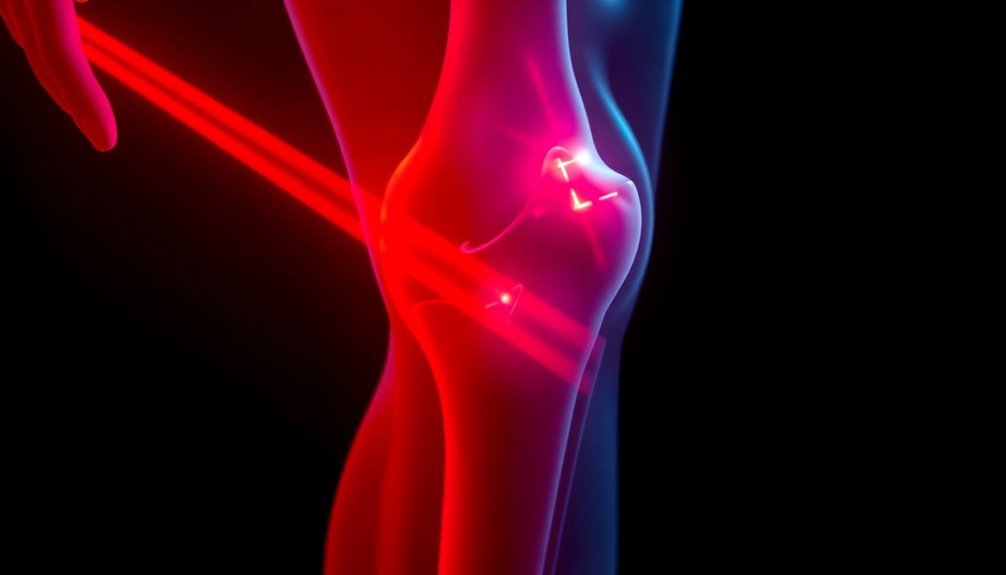
A beam of light can do more than illuminate—it can heal. When you're considering light therapy for knee pain, you'll need to understand how this innovative treatment works.
Light therapy harnesses specific wavelengths and intensities of light that penetrate your tissues, triggering natural healing processes within your cells.
The science behind light therapy involves photons—tiny particles of light energy—that your cells absorb. These photons interact with mitochondria, your cells' power plants, stimulating them to produce more energy.
This increased cellular activity promotes blood flow, reduces inflammation, and accelerates tissue repair. The effectiveness of treatment depends on the time of exposure needed, which varies based on light intensity and wavelength.
You'll find two main types of light therapy: one that works through your skin using specific wavelengths like red and near-infrared light, and another that works through your eyes. For knee pain, you'll want to focus on the skin-penetrating type.
The technology uses artificial light sources that mimic natural sunlight but without harmful UV and infrared rays.
Modern light therapy devices come in various forms, from handheld units to larger panels. They're designed to deliver precise wavelengths at specific intensities, making them both safe and effective for treating joint pain and promoting tissue healing.
Optimal Wavelengths for Knee Relief
Based on extensive clinical research, specific light wavelengths stand out as particularly effective for knee pain relief. The most effective wavelengths fall into two primary ranges: 785-860 nm and 904-905 nm. With knee osteoarthritis affecting 37% of people over sixty, finding effective light therapy treatments is crucial.
Treatments using 785-860 nm wavelengths work best at doses of 4-8 joules per treatment spot, while 904 nm wavelengths are effective at lower doses of 1-3 joules per spot.
These wavelengths aren't chosen randomly – they've proven their effectiveness through clinical trials. The World Association for Laser Therapy (WALT) specifically recommends using at least 4 joules per point with 780-860 nm wavelength when treating knee joints.
When you're targeting knee pain, you'll want to apply the light therapy on both sides of the patella to maximize its penetration into the articular cartilage.
For the best results, you should maintain a mean power of 5-500 mW during treatment. If you're using 904 nm wavelength, you'll need a peak power exceeding 1,000 mW.
While research continues to refine these parameters, current evidence strongly supports these wavelength ranges for reducing knee osteoarthritis pain compared to placebo treatments.
Red Light Benefits

Red light therapy offers you powerful surface-level pain relief while penetrating deep enough to reduce inflammation in your knee joints.
You'll experience faster healing as the therapy stimulates cellular repair and increases blood flow to the affected areas. Regular treatments of 2-3 times weekly are recommended for maintaining optimal results and preventing pain recurrence.
The treatment's ability to promote collagen production and trigger your body's natural pain-killing endorphins makes it an effective solution for both immediate relief and long-term knee health.
Surface-Level Pain Relief
Three key mechanisms make surface-level pain relief possible through red light therapy.
First, when you use red light wavelengths of 620-750 nm, they'll increase blood flow to your knee's surface tissues, delivering essential oxygen and nutrients while removing inflammatory waste products. The therapy is particularly effective for joint tissue regeneration, promoting healing in damaged areas.
Second, the therapy stimulates your body's natural pain-relief response by triggering the release of endogenous opioids and endorphins, which help manage your discomfort without medication.
The third mechanism involves direct cellular repair at the surface level. Red light enhances your cells' mitochondrial function and boosts collagen production, which is essential for maintaining healthy joint tissue. You'll notice improved joint flexibility and reduced stiffness as the therapy modulates nerve function and alters nerve cell permeability in your knee's surface tissues.
You can access these benefits through both clinical treatments and home-use devices, though you'll want to consult your healthcare provider first. The non-invasive nature of red light therapy makes it a safe option for surface-level pain management, and you can use it alone or alongside other treatments to maximize pain relief and accelerate healing.
Faster Healing Properties
When exploring the healing properties of red light therapy, you'll find that cellular repair mechanisms work substantially faster than traditional recovery methods. The therapy accelerates healing by increasing blood flow, which delivers essential oxygen and nutrients to your damaged knee areas while removing waste products more efficiently. NASA research has shown that specific light wavelengths can achieve significant healing benefits.
You'll experience enhanced cellular repair through improved mitochondrial function, as your cells absorb photons and produce more ATP – your body's primary energy source. This boost in cellular energy production enables faster tissue regeneration and more effective healing of arthritic knees.
The therapy also stimulates your cells' natural repair processes through enhanced cellular respiration, including glycolysis and the citric acid cycle.
What's particularly beneficial is how red light therapy promotes collagen production and regulates inflammatory processes in your knee joint. It suppresses harmful pro-inflammatory cytokines while stimulating beneficial anti-inflammatory ones.
The treatment penetrates deep into your knee tissues, where it triggers biological processes that speed up recovery. You'll notice improved joint function as the therapy protects and helps regenerate cartilage while stimulating cellular metabolism for effective healing results.
Reduced Joint Inflammation
Building on these accelerated healing properties, the anti-inflammatory benefits of red light therapy offer powerful relief for knee joint issues.
Research shows that red light therapy can boost natural endorphins for enhanced pain relief. When you expose your knee to red light therapy, it triggers a cascade of anti-inflammatory responses in your body. The light penetrates deep into your joint tissues, suppressing pro-inflammatory cytokines while stimulating the release of anti-inflammatory compounds.
You'll experience reduced swelling as the therapy improves blood circulation, delivering essential oxygen and nutrients to your knee joints. The treatment creates beneficial biochemical changes that promote cellular proliferation and decrease inflammation at its source.
What's particularly significant is how red light therapy helps regenerate cartilage and improve the connective tissues surrounding your knee joints.
The therapy's effectiveness isn't just temporary – it works at the cellular level by increasing mitochondrial energy production, which aids in long-term tissue repair. You'll notice improvements in joint mobility and function as the treatment reduces inflammation and stimulates healing processes.
Since it's non-invasive and FDA-cleared, you can safely incorporate red light therapy into your existing treatment plan, complementing other therapeutic approaches like physical therapy and exercise.
Near-Infrared Light Applications
Near-infrared light penetrates deep into your knee tissues, promoting cellular repair and reducing inflammation through enhanced blood circulation.
You'll get the best results by applying near-infrared therapy for 15-minute sessions twice daily over a 10-day period, allowing the light to stimulate mitochondrial energy production.
The therapy's ability to reach deep joint tissues helps increase your knee's range of motion and flexibility, making daily activities more comfortable and less painful. Patients who received infrared light treatment experienced pain reduction over 50% and needed significantly less frequent retreatment compared to those using placebo devices.
Deep Tissue Healing Benefits
Over the past decade, deep tissue healing has emerged as one of near-infrared light therapy's most remarkable benefits. When you're dealing with knee pain, you'll find that near-infrared light, particularly at the 850nm wavelength, penetrates deep into your tissues, targeting not just surface areas but also muscles, joints, and bones beneath the skin.
The therapy works by stimulating your cells' energy production (ATP), which kickstarts your body's natural healing processes. This process enhances your cellular health through cytochrome c oxidase activation, improving oxygen availability for healing. You'll experience reduced inflammation and pain as the light reaches deep into your tissue layers, promoting faster recovery and healing.
If you're suffering from osteoarthritis, you'll likely notice improved joint function and decreased pain levels with regular treatments.
What makes near-infrared light therapy particularly effective is its ability to enhance bone metabolism and accelerate tissue repair. When you combine NIR with red light therapy, you'll often see even better results than using either wavelength alone.
The deep-penetrating nature of NIR light means you're getting therapeutic benefits where you need them most – in the deeper layers of tissue where knee pain often originates.
Optimal Treatment Time Windows
Success with near-infrared light therapy depends heavily on following the right treatment schedule. You'll need to commit to 15-20 minute sessions, ideally twice daily, to achieve the best results. Consistency is essential – sporadic treatments won't deliver the same benefits as regular, scheduled sessions.
For the best outcome, you'll want to follow a structured 10-day treatment course initially. This approach has proven effective in reducing pain and improving function.
During this period, maintain regular intervals between sessions and don't skip treatments. You can enhance your results by combining light therapy with other treatments, such as physical therapy.
Long-term success requires ongoing maintenance. While initial treatment courses can provide significant relief, you'll likely need follow-up sessions to maintain the benefits. You should expect to continue periodic treatments, as this helps prevent symptom regression and extends pain relief duration.
Regular assessments with your healthcare provider will help determine if your treatment plan needs adjustment. Remember, consistent use over weeks and months leads to sustained benefits, so stick to your prescribed schedule for maximum efficacy.
Joint Mobility Enhancement
Through advanced light therapy technology, you can substantially improve your knee joint mobility using near-infrared applications. Near-infrared light penetrates deeper into your tissues than red light, directly targeting joint issues by stimulating cellular energy production and promoting healing at the source of your discomfort.
You'll find that near-infrared therapy offers several key benefits for joint mobility. It reduces inflammation, enhances blood circulation, and accelerates tissue repair.
Clinical studies show it can decrease knee pain by more than 50% while improving your range of motion. If you're looking to avoid surgery, you'll appreciate that it's completely non-invasive.
When choosing a device, you'll need to think about whether LED or laser-based options better suit your needs. Laser devices typically provide deeper penetration, though they're often more expensive.
Look for FDA-cleared devices specifically designed for knee treatment to guarantee you're getting effective therapy. You can even combine near-infrared treatment with other therapies like ultrasound for enhanced results.
The key is maintaining the correct dosage and treatment time to maximize the benefits of mitochondrial stimulation and inflammation control.
Wavelength Penetration Depths
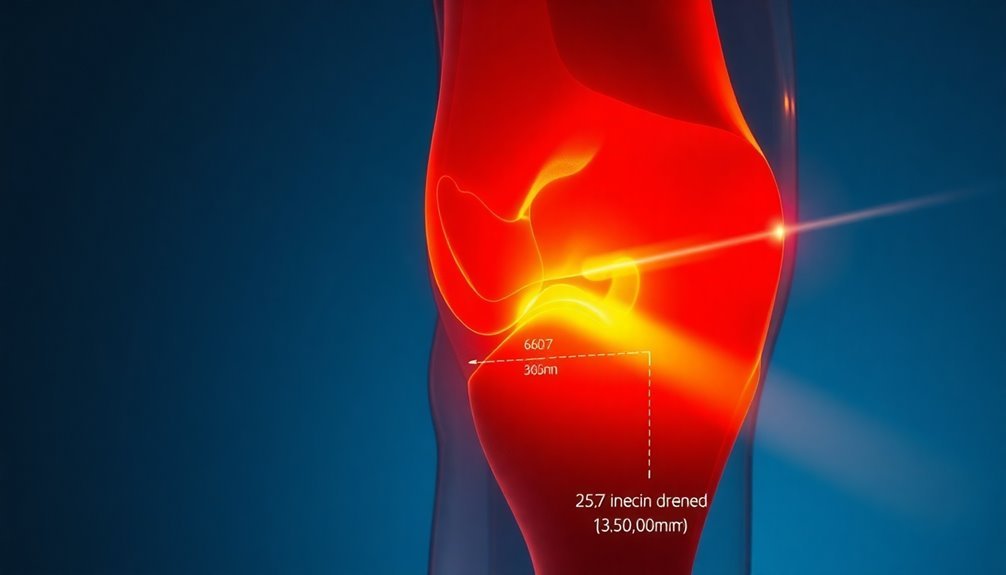
Understanding wavelength penetration is essential for effective red light therapy treatment of knee pain. Different wavelengths penetrate to varying depths, which directly impacts their effectiveness for treating specific knee conditions.
While visible red light (620-750 nm) works well for surface-level issues, infrared wavelengths (785-850 nm or 904-905 nm) reach deeper into your knee's tissues and joints.
If you're dealing with surface-level inflammation or skin-related conditions around your knee
Visible red light therapy using LED devices will be most effective, as it's tailored for cellular metabolism at the skin level.
For deeper knee joint pain and chronic inflammation
You'll want to use infrared wavelengths that can penetrate further into the joint tissues and muscles.
The most effective wavelength range falls between 600-1000 nanometers
Studies have shown significant pain reduction in knee osteoarthritis using 904-905 nm wavelengths.
You'll achieve the best results by combining both red and infrared wavelengths
This approach targets both superficial and deep tissues simultaneously, enhancing blood flow and stimulating cellular repair throughout the entire knee structure.
Cellular Response to Light
The cellular response to light explains why different wavelengths produce varying therapeutic effects in knee tissues. When specific wavelengths hit your cells, they trigger a cascade of biological responses. Red light wavelengths between 620-750 nm stimulate your mitochondria, boosting ATP production and accelerating cellular repair processes.
| Wavelength Range | Cellular Target | Therapeutic Effect |
|---|---|---|
| 620-750 nm | Mitochondria | Enhanced ATP production |
| 785-850 nm | Collagen fibers | Increased tissue repair |
| 904-905 nm | Blood vessels | Improved circulation |
| 375-450 nm | BLUF domain | Cell signaling activation |
| 446 nm | PYP domain | Molecular pathway stimulation |
Your cells contain various light receptors that respond to different wavelengths. When red light therapy is applied to your knee, it promotes endorphin release for natural pain relief while stimulating collagen production to strengthen joint tissues. The therapy also increases blood flow to affected areas, which helps reduce inflammation and accelerate healing. Research shows that wavelengths around 904-905 nm or 785-850 nm are particularly effective for treating osteoarthritis-related knee pain, as they penetrate deeply into joint tissues and trigger ideal cellular responses.
Treatment Duration and Frequency
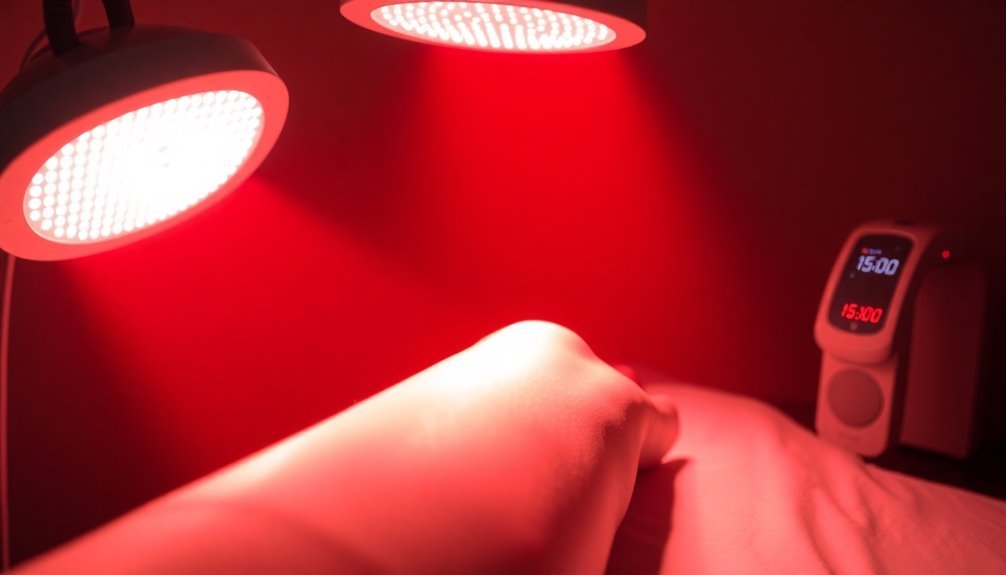
You'll want to schedule 10-20 minute light therapy sessions twice daily for the best knee pain relief.
Following a consistent daily treatment routine is more effective than sporadic longer sessions, with experts recommending 10-16 total sessions for significant pain reduction.
While initial treatments should be frequent, you can extend the time between maintenance sessions once you've achieved pain relief, though maintaining a regular schedule is crucial for long-term benefits.
Optimal Session Length
According to clinical research, effective red light therapy for knee pain requires precise timing and consistent application. The ideal session length ranges from 10-15 minutes per treatment, with studies showing significant pain reduction and functional improvement when following this timeframe.
You'll want to keep your sessions brief but regular, as shorter consistent treatments prove more effective than longer, sporadic sessions.
For the best results, you should:
- Limit each session to 10-15 minutes maximum
- Schedule treatments twice daily, spacing them apart
- Maintain consistent treatment times throughout the week
- Track your progress and adjust as needed based on your response
You can expect over 50% pain reduction when following these guidelines with the proper wavelengths (904-905 nm or 785-850 nm). Remember, you shouldn't exceed two 15-minute sessions per day, as more isn't necessarily better with red light therapy.
It's crucial to work with your healthcare provider to establish the right treatment schedule and monitor your progress through routine assessments. This therapy can be particularly effective when combined with other treatments like physical therapy or exercise programs.
Daily Treatment Schedule
Building on proper session timing, establishing a consistent daily treatment schedule maximizes the benefits of red light therapy for knee pain.
You'll want to start with 2-3 sessions per week for acute knee conditions, with each session lasting 10-15 minutes. If you're dealing with chronic knee pain, daily sessions might be necessary initially.
You should adjust your treatment frequency based on how your knee responds to therapy. As your pain levels decrease, you can gradually reduce the frequency of treatments. However, don't stop completely once you feel better – maintaining regular sessions helps preserve the benefits you've gained.
It's more effective to have short, consistent treatments than longer, sporadic ones.
Work with your healthcare provider to create a personalized treatment plan that fits your specific condition. A typical protocol might include 3-4 whole-body treatments and 2 handheld treatments per week for 4-12 weeks.
You'll need regular assessments to fine-tune your schedule as your condition improves. Remember to communicate any changes in your pain levels with your healthcare provider so they can adjust your treatment plan accordingly.
Long-Term Relief Planning
For successful long-term knee pain management, combining proper treatment duration with consistent frequency creates lasting relief. Studies show that 15-minute sessions twice daily, particularly over a 10-day period, can substantially reduce pain and improve function.
While there's no universal protocol, maintaining regular treatments for at least two weeks often yields the best results.
You'll want to follow these key guidelines for the best long-term benefits:
- Start with twice-daily 15-minute sessions for the first two weeks to build a strong foundation for pain relief
- Monitor your response and adjust the frequency based on your pain levels, aiming for treatments at least 5 days per week
- Consider maintenance sessions after initial improvement to prevent pain recurrence
- Combine light therapy with other treatments like physical therapy and exercise for thorough relief
Remember that benefits can last several months after treatment, but you might need periodic maintenance sessions to sustain relief.
Work with your healthcare provider to develop a personalized long-term plan, as individual responses vary. They'll help you determine the ideal treatment rhythm and adjust the protocol based on your specific needs and progress.
Professional Versus Home Devices
When choosing between professional and home light therapy devices for knee pain, you'll encounter significant differences in quality, features, and accessibility.
Professional devices offer superior precision with adjustable settings and multiple wavelengths, backed by strict medical certifications and safety standards. While they're more expensive, they typically deliver more consistent results and may be covered by insurance when prescribed by healthcare professionals.
Home devices, though less precise, offer distinct advantages in convenience and affordability. You'll find them in various forms, including wraps and handheld units, designed for easy use without professional supervision.
They're portable, user-friendly, and don't require a prescription, making them accessible for regular treatment at home or while traveling.
Consider your specific needs when deciding between the two options. If you require targeted therapy for severe knee pain or prefer professional oversight, a certified medical device might be worth the investment.
However, if you're looking for a convenient, cost-effective solution for mild to moderate knee pain, a quality home device could meet your needs while offering flexibility in your treatment schedule.
Research-Backed Wavelength Combinations
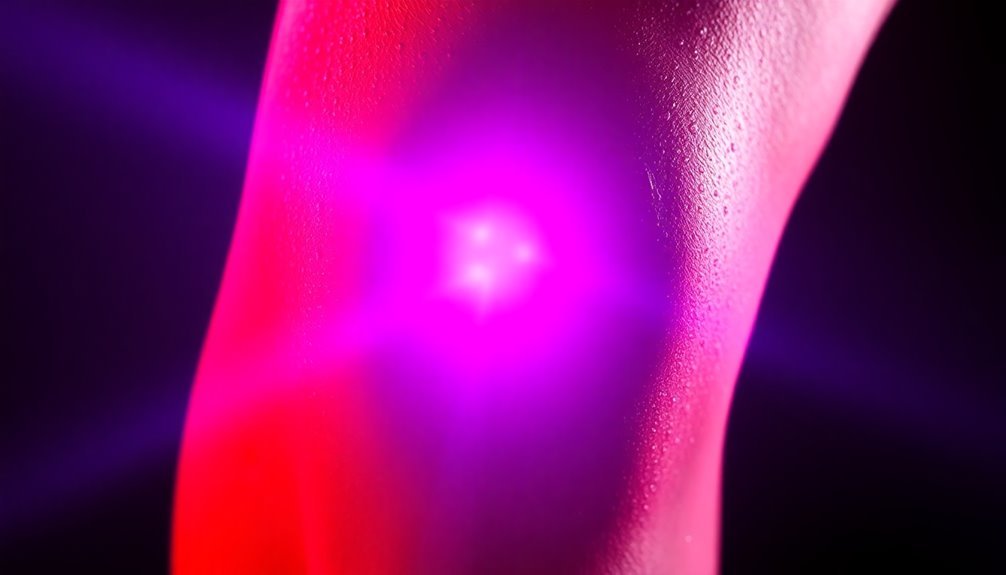
Scientific research has identified specific wavelength combinations that maximize the effectiveness of light therapy for knee pain. Studies show that combining red light (630-660nm) with near-infrared wavelengths (800-850nm) provides thorough relief by targeting both superficial and deep tissue layers of the knee joint.
- Red light wavelengths (630-660nm) effectively treat surface-level inflammation and shallow joint discomfort, making them ideal for addressing pain in the outer layers of your knee.
- Near-infrared wavelengths (800-850nm) penetrate deeper into the joint tissue, stimulating healing processes and reducing inflammation in areas that visible light can't reach.
- The best treatment protocol uses 4-8 joules per spot with 785-860nm wavelengths, focusing on both sides of the patella to maximize exposure to the articular cartilage.
- Combination therapy using both wavelength ranges triggers multiple therapeutic mechanisms: it stimulates mitochondrial function, increases collagen production, reduces inflammation, and promotes natural pain relief through endorphin release.
Clinical trials consistently demonstrate that this dual-wavelength approach substantially improves physical function and reduces pain in patients with knee osteoarthritis, making it a reliable treatment option for chronic knee pain.
Clinical trials consistently demonstrate that this dual-wavelength approach substantially improves physical function and reduces pain in patients with knee osteoarthritis, making it a reliable treatment option for chronic knee pain.
Safety Considerations and Precautions
Despite the general safety of light therapy for knee pain, taking proper precautions guarantees both your wellbeing and the best treatment results.
You'll need to wear protective eyewear or cover your eyes during treatments, and always maintain the recommended distance between the device and your knee.
Before starting red light therapy, consult your healthcare provider, especially if you have underlying medical conditions, implants, or if you're pregnant or breastfeeding.
When using your device, strictly follow the manufacturer's instructions regarding exposure times and intensity settings. Start with lower intensities and gradually increase them under professional guidance.
Choose a device that's specifically designed for knee pain and includes essential safety features like automatic shut-off timers and skin contact sensors. You'll want to monitor your skin for any reactions, though side effects are typically mild and may include temporary redness or dryness.
Remember that red light therapy isn't a replacement for medical treatment but rather a complementary therapy. For the best results, maintain consistency in your treatment sessions and combine light therapy with other approved pain management strategies your healthcare provider recommends.
Patient Success Stories

Real-world evidence demonstrates the remarkable impact of light therapy on knee pain management. Patients consistently report significant improvements in their quality of life, with studies showing over 50% reduction in osteoarthritis pain after treatment. You'll find that both red light and infrared therapy users experience rapid relief, often noticing improvements after just one or two sessions.
- You can expect enhanced mobility and stability in your knees, as patients regularly report improved joint function and reduced need for rest periods after their light therapy treatments.
- If you're dealing with chronic inflammation, you'll benefit from the cellular-level healing properties, as LLLT stimulates tissue repair and reduces swelling in knee tissues.
- You'll likely notice improved energy levels and reduced stiffness, especially when combining light therapy with other treatments like PEMF.
- Your overall health may improve beyond just knee pain relief, as many patients report better sleep patterns and decreased reliance on pain medications.
Clinical trials support these success stories, showing significant functional improvements in patients using red and infrared wavelengths.
You'll join countless others who've found sustainable, drug-free relief through light therapy for their knee conditions.
Future of Light Therapy
Emerging innovations in light therapy technology promise to revolutionize knee pain treatment in the coming years. You'll soon see more advanced wearable devices specifically designed for at-home knee treatments, making it easier to maintain consistent therapy sessions.
These devices will likely combine multiple wavelengths, particularly red and near-infrared light, to maximize therapeutic benefits.
Research is rapidly advancing our understanding of which wavelengths work best for specific knee conditions. Scientists are investigating ideal dosing parameters, including wavelength combinations, power density, and treatment frequency.
You'll benefit from more personalized treatment protocols based on your specific condition and symptoms.
The integration of light therapy with other treatment modalities will become more common, and you'll find it increasingly available in medical settings. Healthcare providers are developing thorough pain management plans that incorporate light therapy as a non-drug alternative.
You can expect to see more clinical trials exploring new applications for knee pain and improved guidelines for treatment parameters.
As technology advances, you'll have access to more precise delivery systems and better-controlled treatment options, making light therapy an even more effective solution for knee pain management.
Frequently Asked Questions
Can I Wear Clothes During Light Therapy Treatment for Knee Pain?
You shouldn't wear clothes during light therapy, as fabric blocks ideal light penetration. For best results, expose your skin directly to the treatment. If needed, wear only thin, light-colored clothing around the treatment area.
Does Medicare or Insurance Typically Cover Light Therapy Devices?
You'll find Medicare and insurance coverage varies widely for light therapy devices. You'll need a prescription and proof of medical necessity. It's best to check with your provider about specific coverage requirements.
How Long Do LED Light Therapy Devices Typically Last Before Needing Replacement?
You can expect your LED light therapy device to last 25,000-50,000 hours or more. With daily use of one hour, that's decades of use. You'll likely replace it for upgrades before it fails.
Can I Use Light Therapy Immediately After Knee Surgery?
Yes, you can use light therapy right after knee surgery. It's safe and effective for reducing pain and swelling. Just make sure you've got your surgeon's approval and use FDA-cleared devices for best results.
Should I Continue Using Light Therapy After My Knee Pain Subsides?
Yes, you should continue light therapy even after your knee pain subsides. It'll help prevent future flare-ups, maintain reduced inflammation, and promote long-term joint health through regular sessions of 10-20 minutes multiple times weekly.
In Summary
You've now learned the most effective light wavelengths for knee pain relief, focusing on red light (630-670nm) and near-infrared (810-850nm) combinations. While results vary, these wavelengths penetrate deeply and work together to reduce inflammation and promote healing. Always follow safety guidelines and consult your healthcare provider before starting light therapy. With proper application, you're taking a promising step toward drug-free pain management.

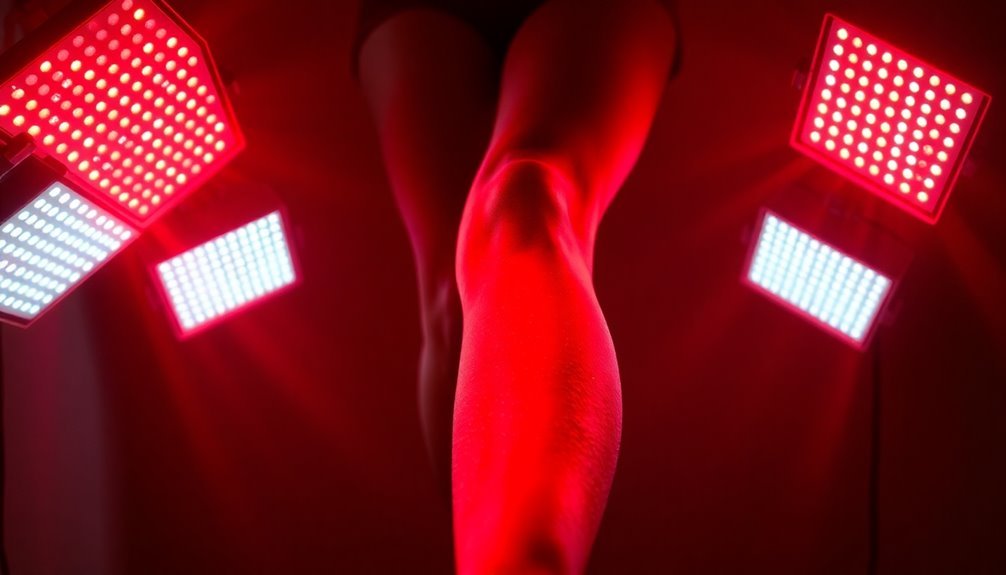
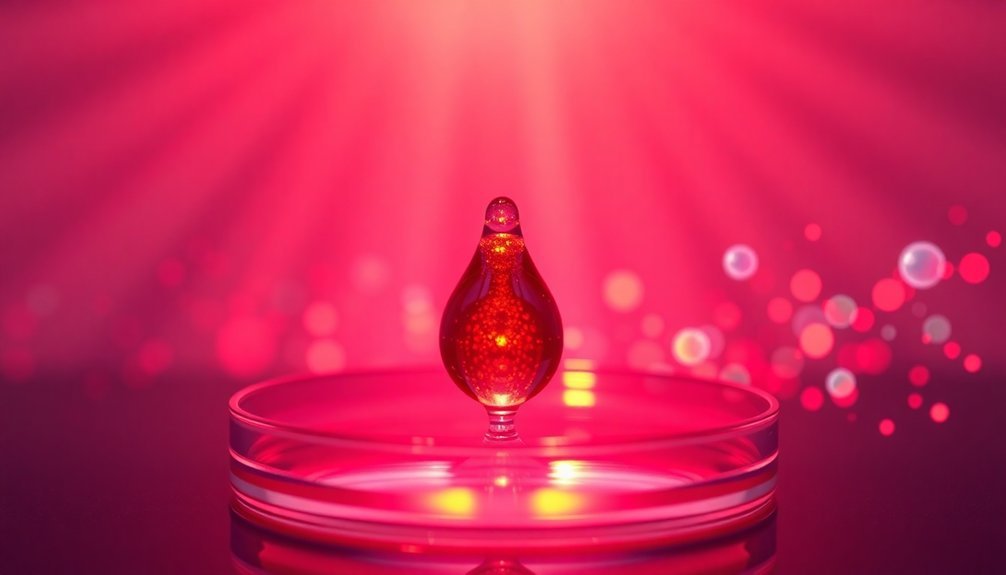


Leave a Reply